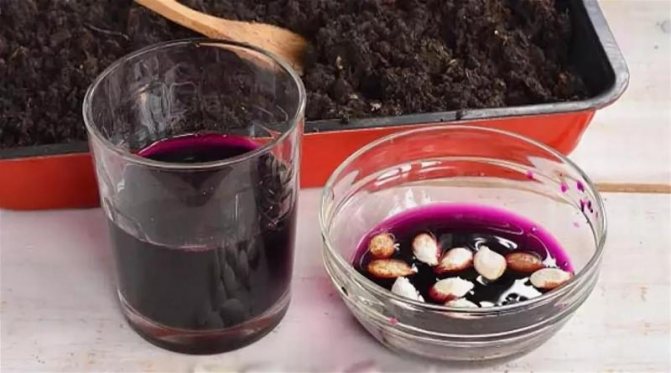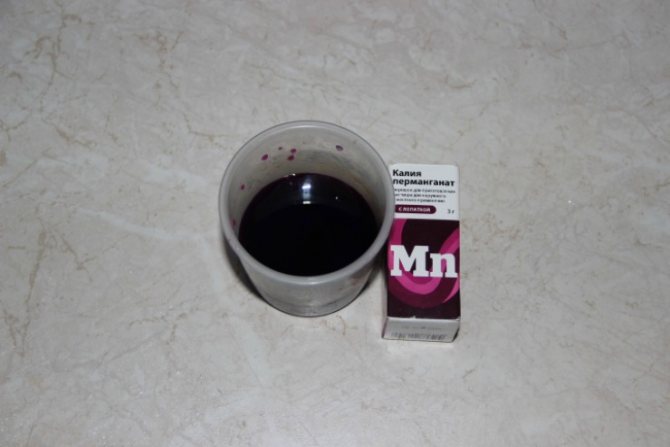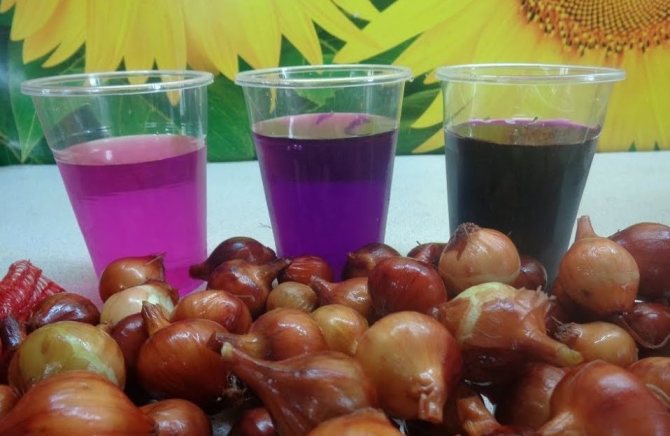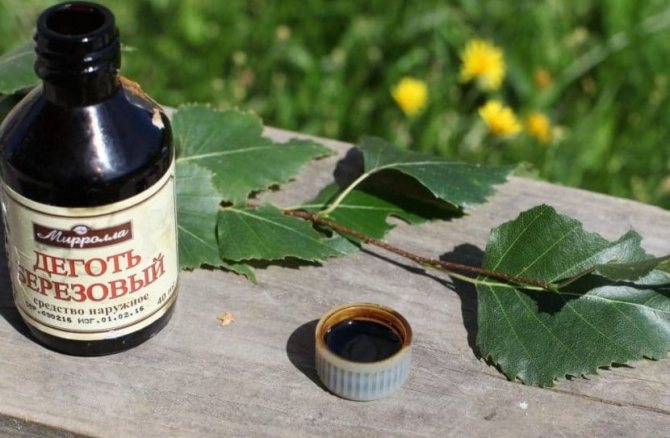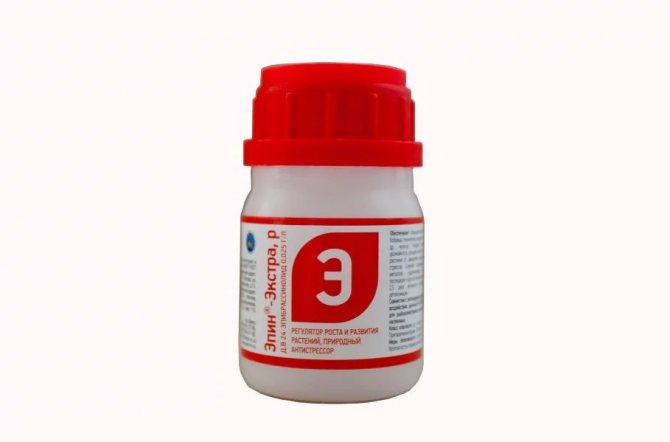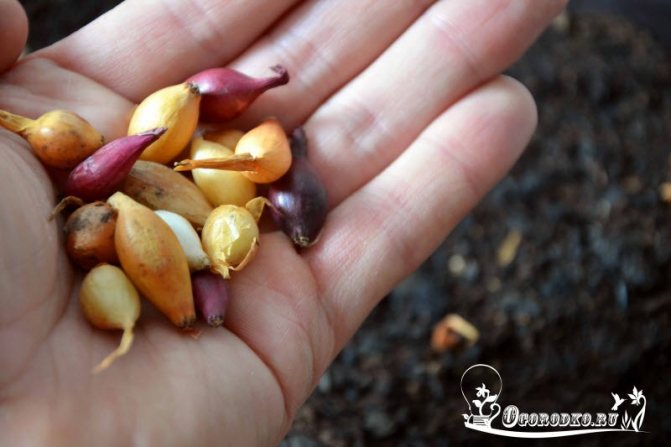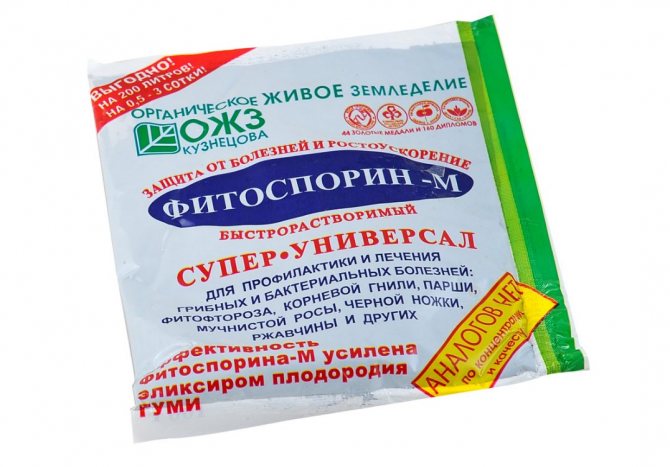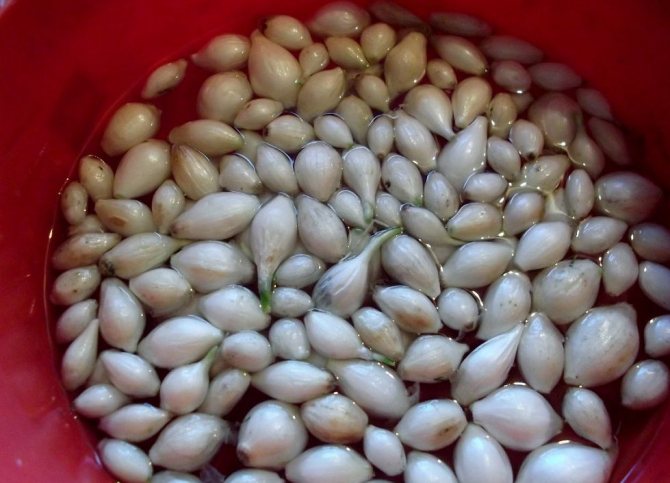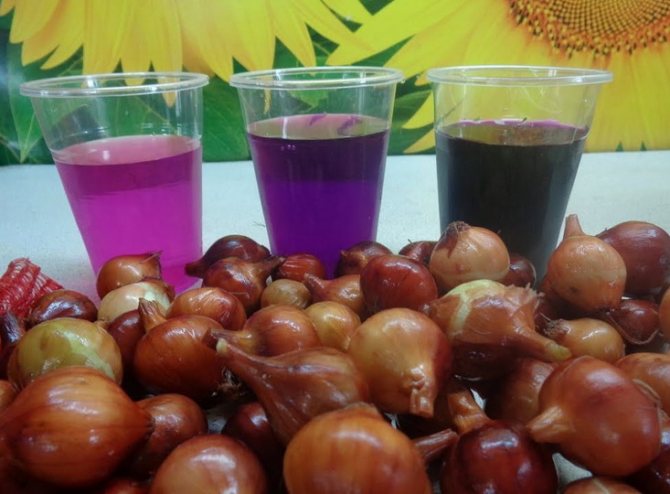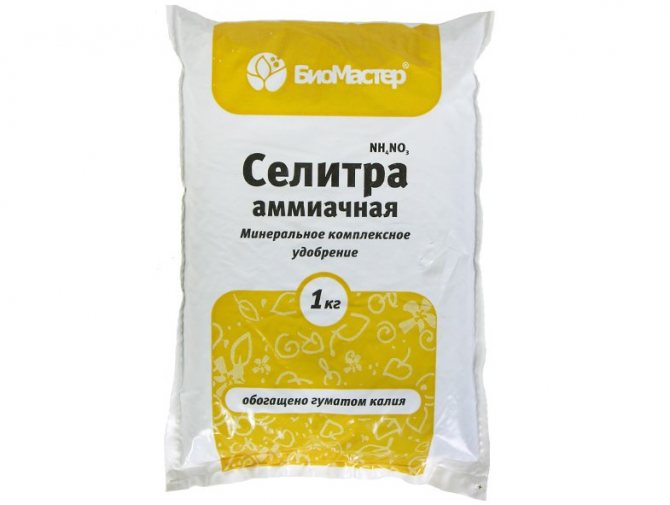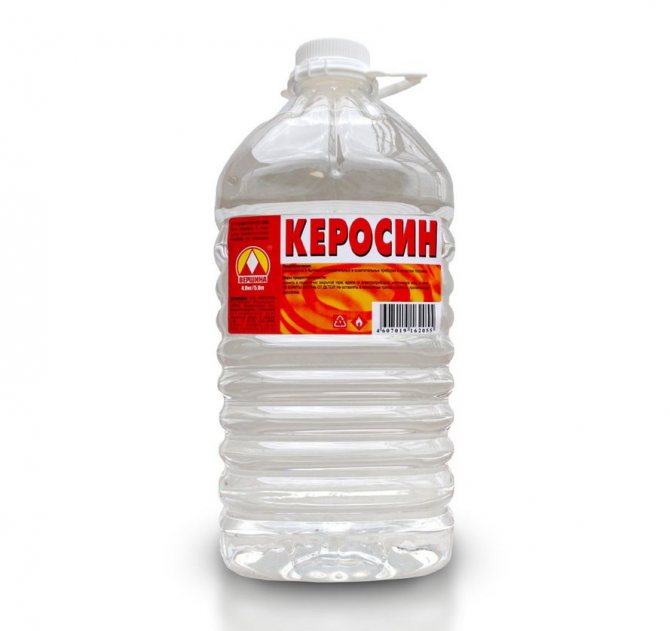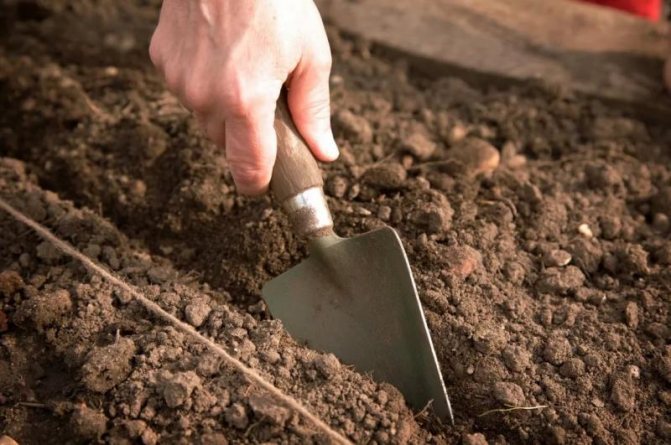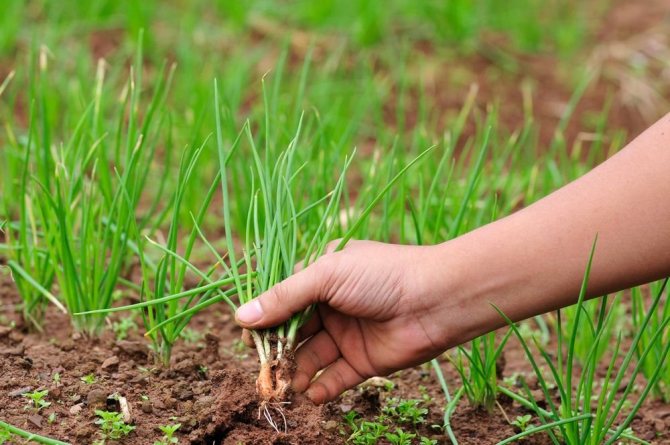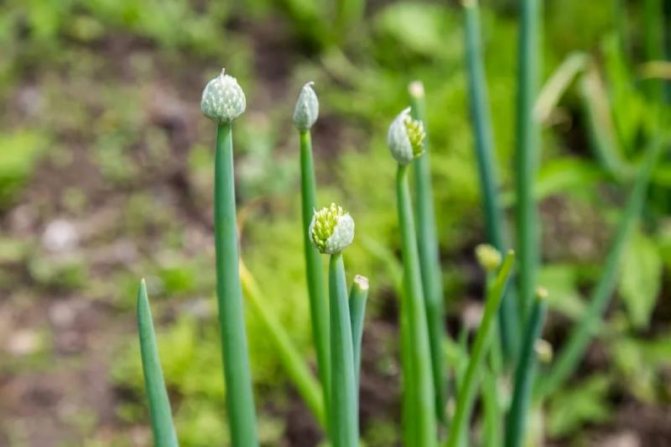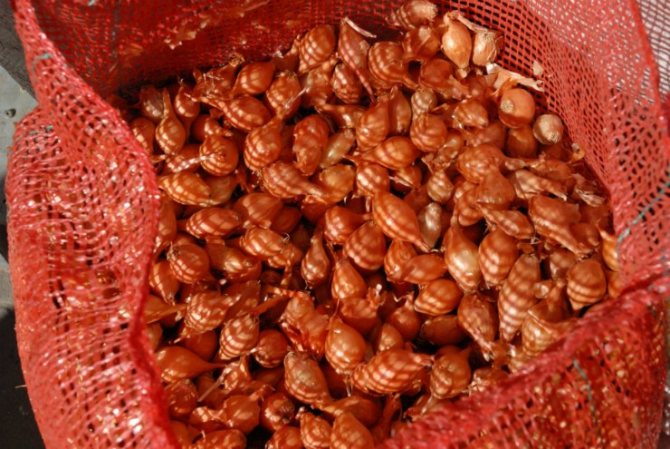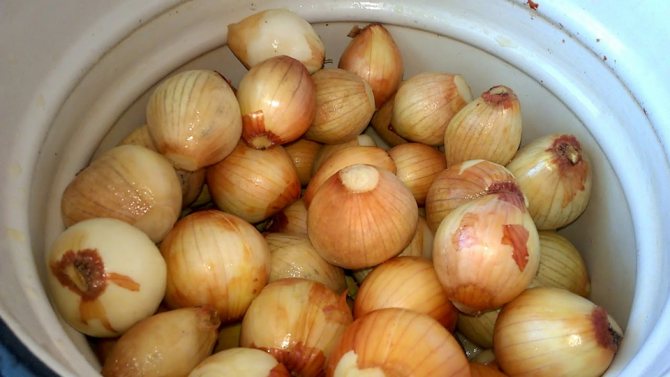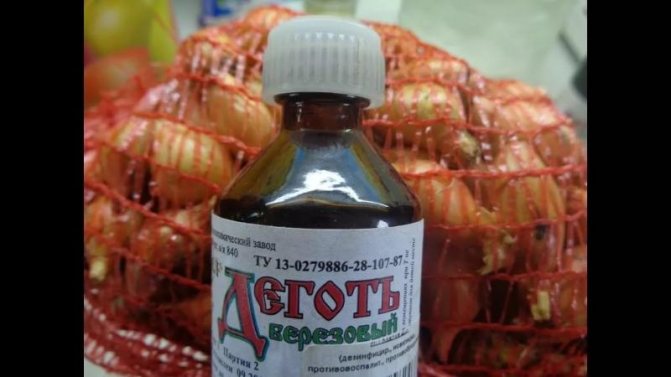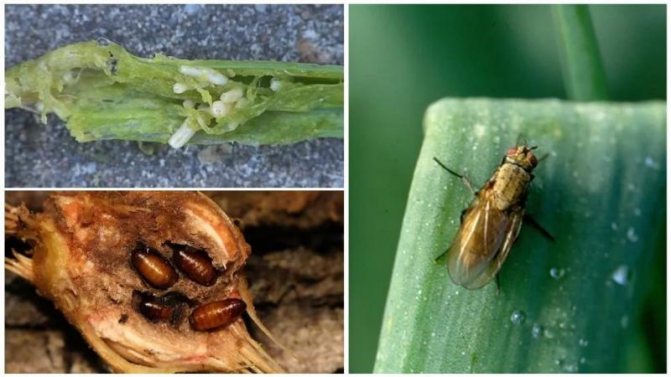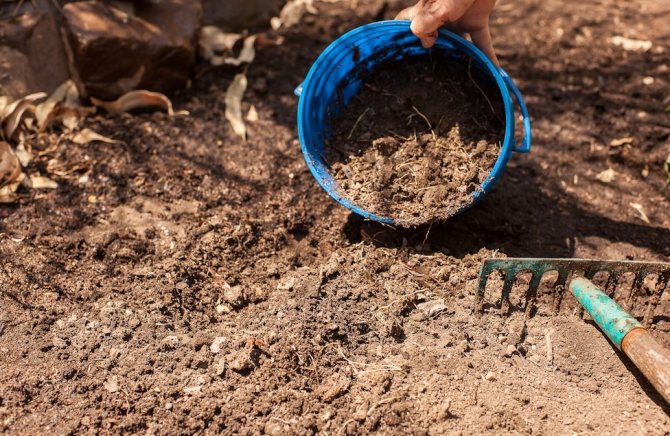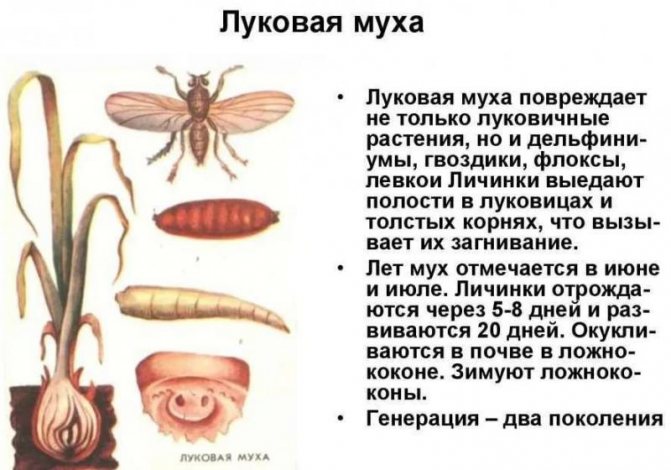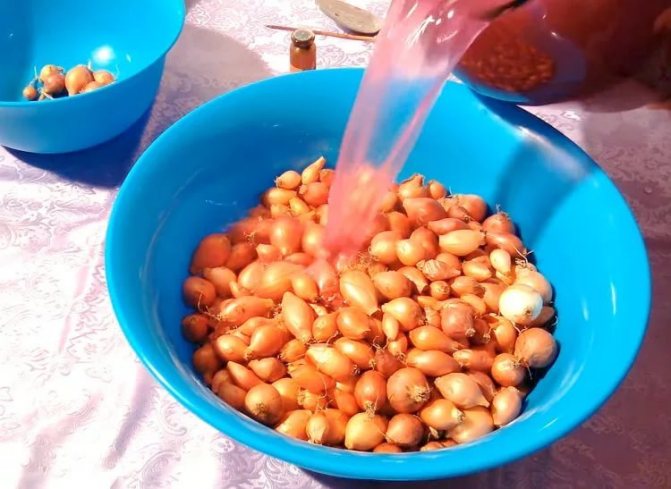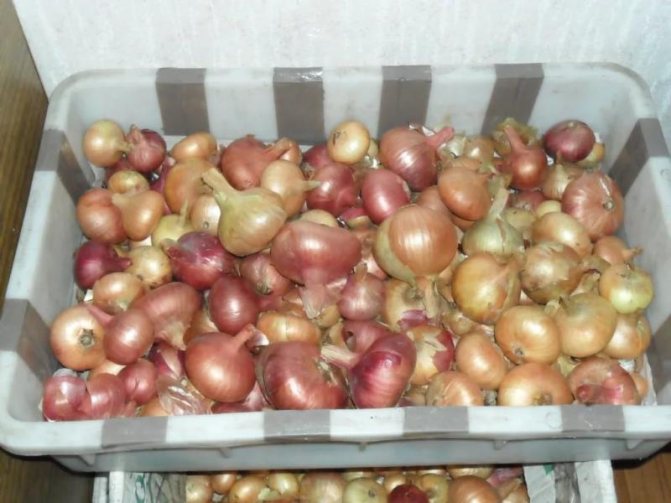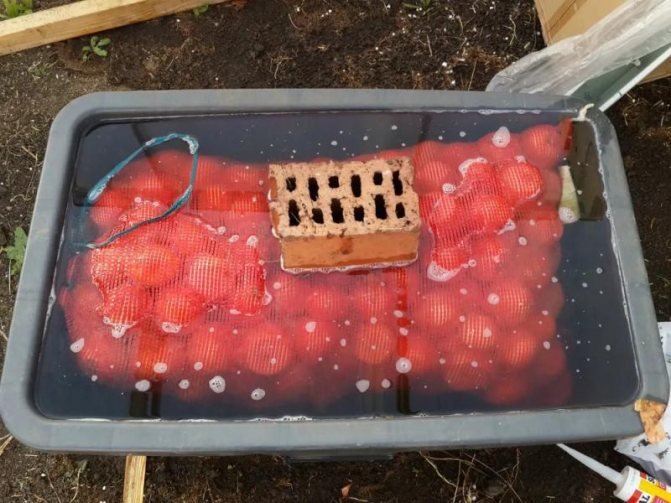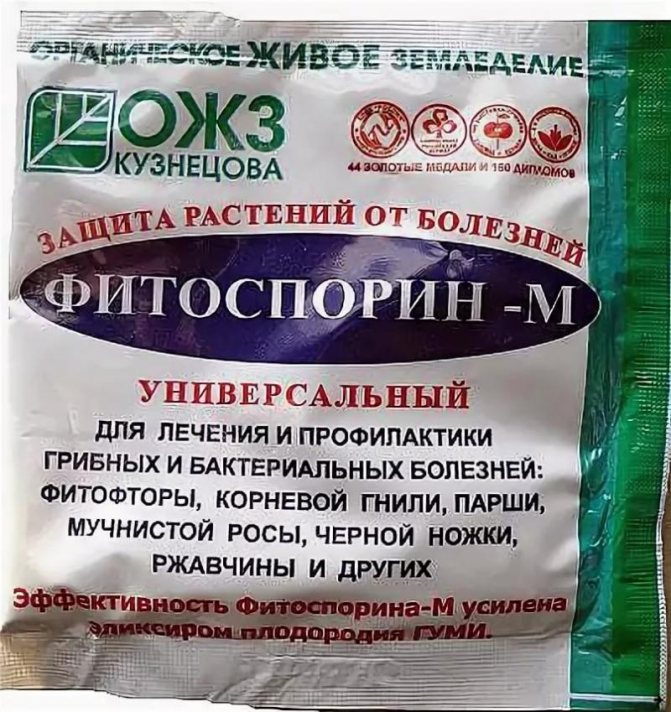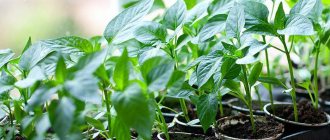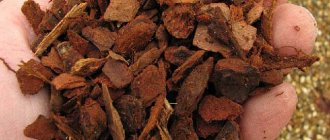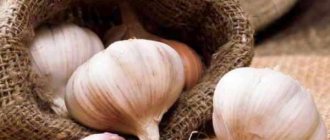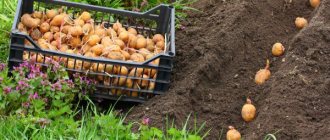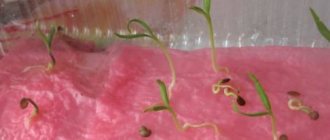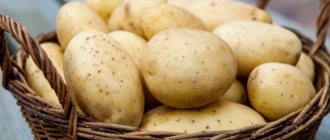It seems that growing a decent onion is not difficult at all. However, getting a good harvest on time is not easy. In this article, we will consider one of the important points - how to process the onion before planting and how to properly prepare it for planting in the spring.
It is difficult to imagine a summer cottage without friendly onion beds. Thanks to the many varieties, each gardener plants his own collection of onions. There are several popular varieties: onions, batun, shallots, leeks, chives).
To dig up a high-quality onion, it is not enough to feed and water the beds on time. Only due to the correct and timely preparation of onions for planting, you can get planting material that will germinate well, be disease resistant and give an excellent harvest.
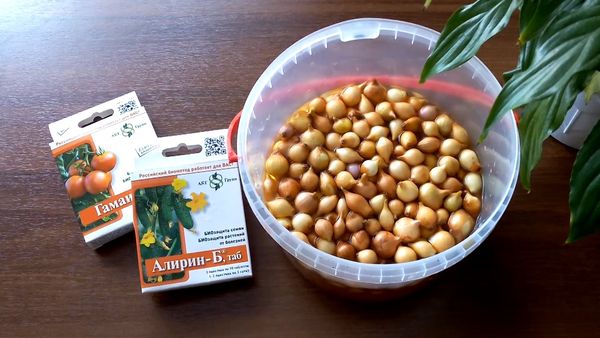
When to plant onion sets, family on the head in the spring?
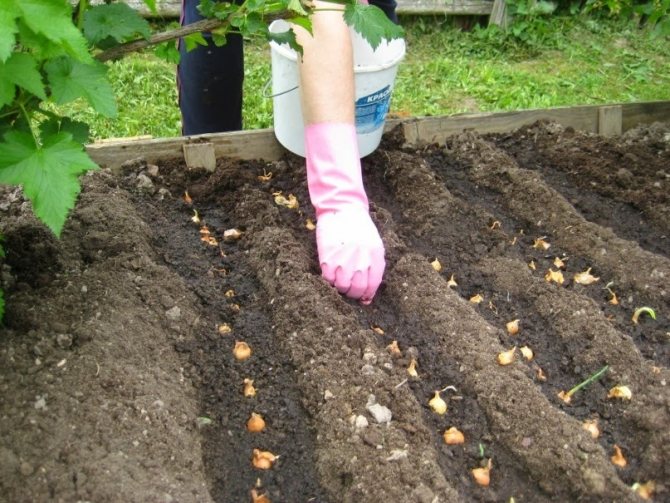

How to plant onion sets on the head in spring?
Sevka planting should be carried out in the spring after the end of frost and the likelihood of night frosts.
- If the spring is early, then you can plant the onion on the head from mid-April (if frost hits after sowing, the onion can go into a feather).
- In order not to take risks, "gardening masters" plant onions on the head in mid-May, focusing on the gardener's calendar.
Planting date also directly depends on the size of the planting..
- It is recommended to calibrate the bulb heads on the eve of sowing. In other words, the planting material needs to be divided into small, medium and large heads.
Landing is carried out in ascending order.
- Small sets are planted first, in early to mid-May.
- It is customary to stick a medium bow (from 1 to 2 cm) into the ground half a month after a small one.
- A large set must be planted last to avoid it growing into a feather.
Very often, among the planting material, you can find rather small bulbs (no more than 1 cm) - such a plant is recommended to be planted only in greenhouses.
- The family onion "kushchevka" or the so-called "shallot" is considered more resistant to frost, therefore it can be planted from mid-April.
Optimal timing for onion processing
Onion sets are processed just before planting, which usually occurs in the spring. Most often, the planting period falls on the end of April or the beginning of May, but in the southern regions it can begin to be planted as early as March. The main thing is that the temperature is set at + 10 ° C. Do not plant bulbs in cold ground or at higher temperatures. Some gardeners plant part of the onion before winter to get an earlier harvest.
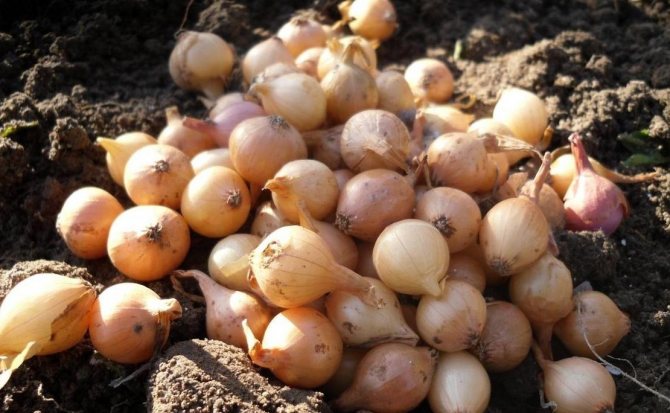

Such onions are unsuitable for long-term storage and are used during the summer season, but they ripen several weeks earlier. Disembarkation is carried out in autumn, usually at the end of October or beginning of November at ground temperatures of + 2 ... + 4 ° С. You should know the weather forecast in advance and plant the bulbs 3-4 weeks before the expected frost, so that it takes root, but does not germinate.
Important! You should not do winter planting of onions if your area has little snow, severe winters or frequent thaws. In these cases, crops may die, and no treatment will help.
How to plant onion sets and family onions in the spring?
Sevka preparation
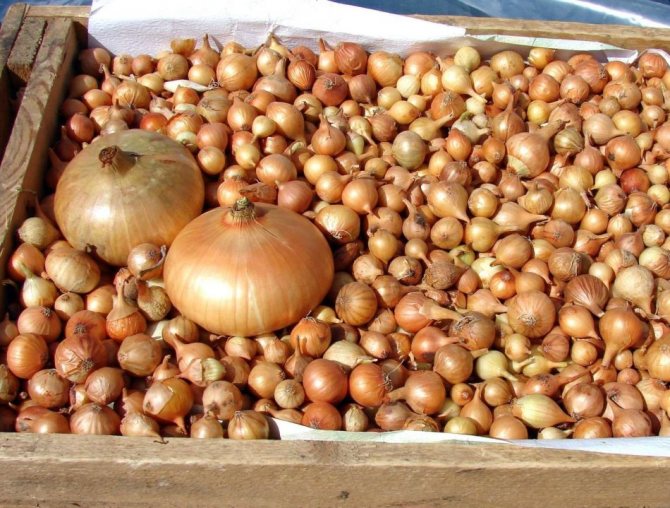

Preparation of planting material
Planting onions in the spring always begins with the calibration of the planting material. (described above)
- If the onion heads were purchased and not grown last year, then they must be dried.
- If the planting material remained from last year, then in winter it must be properly stored - at a temperature of +18 degrees.
An important condition before planting your own material is to warm it up.
Warming up the seed
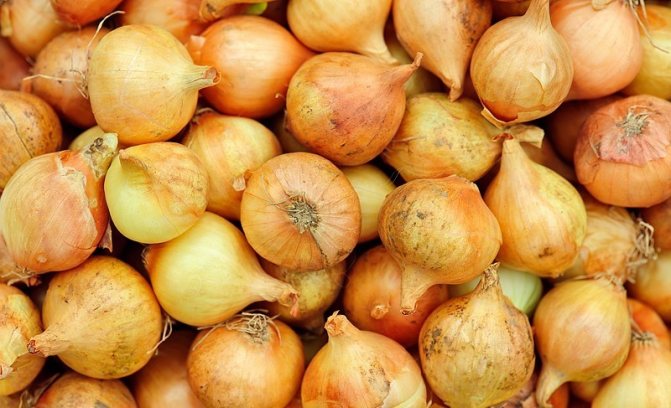

Warming up the seed before planting
Method number 1
- On the eve of planting, we place the onion heads in conditions with a temperature of +20 degrees.
- We keep this temperature regime for about 20 days.
- After the specified time has elapsed, we create a setting of conditions of + 30-40 degrees for 10 hours.
- We make sure not to overexpose the planting material at rather high temperatures.
- On the eve of planting a sevka heated in a similar way, we process it with means that stimulate growth (read below).
Method number 2
- We put the set in hot water (+ 40-50 degrees) for 10-15 minutes.
- After the specified time has elapsed, we transfer the bulbs to cold water for the same 10-15 minutes.
- At the end of 15 minutes, immerse the seedlings in a solution of complex mineral fertilizer for onions for 5-6 hours.
Planting onions


Planting onion sets
- Before planting onions, it is necessary to make furrows up to 4 cm deep in the prepared area (in general, the depth directly depends on the size of the set) at a distance of 15-25 cm from each other.
- It is necessary to stick the bulbs into the finished grooves at a distance of 7 cm from each other so that after they are buried, the dry part of the seed is barely visible on the surface.
Some experienced gardeners recommend watering the onion thoroughly after planting, and then making mulch from straw or sawdust.
Expert advice
Experts recommend keeping the planting material in a solution of any growth stimulant (for example, "Zircon"). This promotes the awakening of the root system and the beginning of development. After such a procedure, the treatment with "Fitosporin" is applied (the instructions for preparing a solution for soaking the planting material should be followed exactly). This biological product fights pathogens, and then it is not necessary to process it with copper sulfate.
The listed complex of agrotechnical measures is laborious, but it is the key to a successful harvest. Let China and India take the first place in the world in onion production (70 million tons), and by the amount of consumption per capita - by the inhabitants of Libya (more than 33 kg per year), it is also important for the inhabitants of our country to grow healthy, beautiful onions, to be able to preserve them. until the new harvest, and in the spring, repeat all over again. The process is like a small battle. No wonder in the Middle Ages, the French knights gave in exchange for one prisoner to their enemies Saracens as much as 8 onions!
Preparing the beds for onions in spring
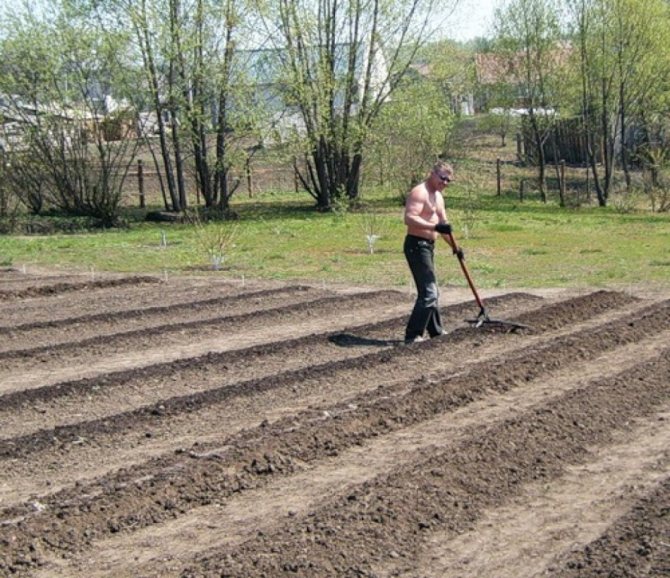

Preparing the beds for sowing onions in spring
For planting onions, it is necessary to choose open, well-lit and ventilated areas of land.
- As a rule, the preparation of the site for planting onions is carried out in the fall, therefore it must be borne in mind that the piece of land allocated for these purposes should not be in the lowlands, where water stagnates for a long time in the spring.
- Water can be a dangerous enemy for onions, and its heads will begin to rot in the ground, thereby ruining the entire crop.
- Sevok does not like acidic soils... If the soil in the selected area is acidic, lime can be added to it, which neutralizes the acid.
- It is not recommended to plant sevok on the site, where the same onion was grown the day before - the site must be given at least three years for rehabilitation.
- Good forerunners for onions onions are considered to be potatoes, tomatoes, cabbage, cucumbers, beans, zucchini, peas, pumpkin.
- The scheme has proven itself very wellwhen carrots are planted close to onions - the smell of carrots drives the onion fly away, and the smell of onions neutralizes the carrot fly.
- During the autumn preparation of the site, its it is recommended to dig to a depth of a shovel's bayonet (15-20 cm) and level.
- The best option is considered autumn fertilizing of soil under onions with manure, peat compost or superphosphate mineral fertilizers.
Important! It is strictly forbidden to fertilize the soil immediately before planting, since the bow will go to the arrow, and not to the head.
Preparing the soil for planting onions
Properly processed onion seeds can produce a good harvest. But for this, you will need to choose the right place on the garden plot and properly prepare the soil before planting them. It is better to start this process in the fall. Remember that leek seeds germinate best in well-sunlit areas. They are also hygrophilous, but at the same time do not tolerate excessive amounts of moisture. Therefore, it is required to choose a place open to the sun's rays, where there is no groundwater at all, or they lie at great depths.
The selected area in the fall needs to be well dug up and fertilized into the soil (rotted manure or its mixture with peat is suitable). On acidic soils, it is better to perform liming, which will create optimal conditions for growing onions.
It is undesirable to apply fertilizer before planting, unless you are going to grow onions exclusively on a feather. In addition, such treatment will lead to rapid growth of weeds, and you will have to weed the beds all summer, getting rid of them. All that needs to be done in the spring is to loosen the soil a little, break the hard crust and start planting.
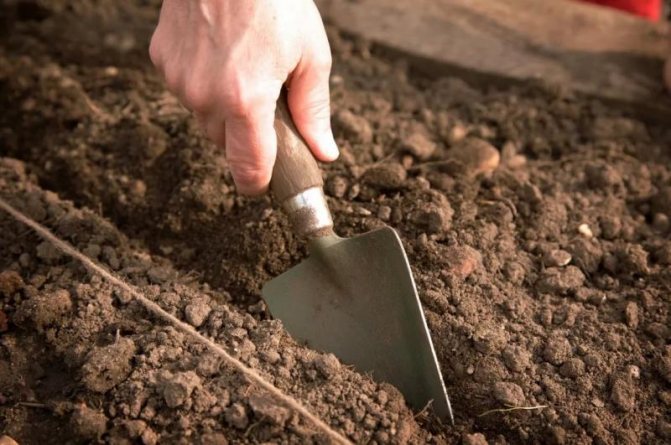

The plant grows well in areas where crops such as peas, cabbage, potatoes and tomatoes were previously cultivated. As an additional protection, onions can be planted in the immediate vicinity of carrots. Its phytoncides will be a powerful barrier to onion flies and will allow you to get an excellent harvest. When planting a seed, be sure to water it with a little water, and also sprinkle it with sawdust - they will help prevent wet soil from sticking to the seeds.


How to process onions before planting in spring and how to soak them?


Processing onions before planting
In addition to the heat treatment, which was described in the article above, other antiseptic and nourishing procedures are also applied to the seeding before planting:
Processing in potassium permanganate
- To achieve an antiseptic effect, we soak the seedlings a week before planting for 20-30 minutes in a light solution of manganese (for 10 liters of water, 30 g of potassium permanganate).
- After soaking, rinse and dry the onion thoroughly (if you are not going to plant it right away).
- There is an option to plant it in the ground immediately after potassium permanganate without washing.
Wood ash treatment
- The decay process can be helped by the treatment with a solution of wood ash.
- To prepare a solution in 10 liters of water, we dilute 500 g of ash.
- Before lowering the sevka into the solution, we put it in a grid and already in it we immerse it in water with ash for five hours.
- After the specified time, we take out the onion and send it to dry in the sun for a couple of hours.
- The dried planting material is immediately planted in the ground, it is protected from decay and received top dressing for powerful growth.
Top dressing with complex fertilizers
- We dilute a tablespoon of complex fertilizers for onions in 10 liters of water
- We lower the sowing for 8-10 hours in the fertilizer solution
Copper sulfate treatment
Such manipulation will protect the culture from fungal diseases.
- We dilute a teaspoon of copper sulfate for 10 liters of water
- Dip the set in the solution for 10-15 minutes
- We take out the onion from the solution, rinse it thoroughly and dry it
"Babushkin" method of treating seedlings with salt from stem nematode
- For a week, we dry the bulbs indoors at a temperature of +25 degrees.
- In 2 liters of water we dilute 2 tablespoons. salt
- Soak the set in brine for 3 hours
- We take out the onion from the solution, rinse it and dry it
Saltpeter treatment
- In 10 liters of warm water (+40 degrees) we dilute 1 tbsp. saltpeter
- Soak the set in the solution for 20-30 minutes
- It is best to use nitrate treatment for early planting of onions from diseases and for better growth of the head and feather
Fungus treatment with Fitosporin
- Dissolve about 35-40 g of Fitosporin in a 10 l container and soak the onion planting material in this solution for about 30 minutes.
- We immediately plant the onions in the garden.
In addition to the described onion processing methods, there are also industrial growth activators and chemicals for processing seedlings; they are used only for spring planting of onions and cannot be used for planting before winter.
- Biostim or Silkom - these activators are sold with detailed instructions. Your task is to clearly follow this instruction, warming up the onion before this, as mentioned above.
- Epin-Extra - a couple of capsules dissolve in a 10 l container of water for no more than 15 minutes. The bulbs will receive a powerful nourishment for the root system, which will increase the growth and yield of the onion.
When choosing a processing method, you should opt for only one of them..
Processing for accelerated growth
The development of onion crops is intensified with the help of complex synthetic compounds. Most often, farmers use compost extracts, biohumus. Among biological accelerators, the most effective are active humates of peat origin and fungicidal agents.
"Humite", obtained from vermicompost, is an analogue of humates. The drug should be diluted with water in accordance with the instructions for use, soaked in a solution of sevok. Onions respond well to treatment with humates and fungicides: metabolic processes are accelerated inside the plants.
Top dressing of onions in the spring on the head
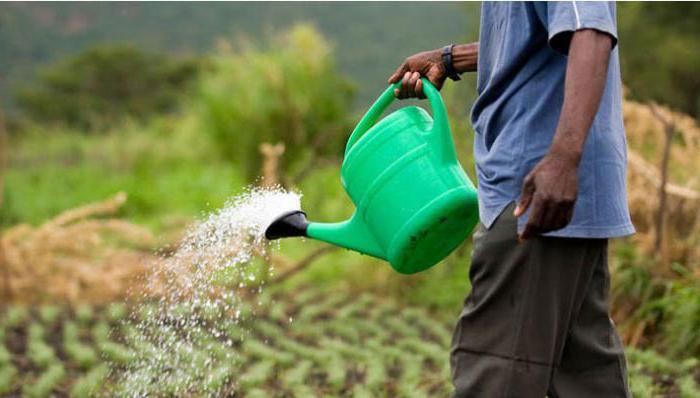

Top dressing of onions in the spring on the head
- Top dressing, or rather fertilizing the soil for onions, is best done in autumn with manure.
- It should be said right away that if the land in which the onion grows on its head is fertile, or if it was sufficiently fertilized in the fall, then it may not need spring feeding at all.
If the fertility of the soil leaves much to be desired, then in the spring the onions can be fertilized.
- The first feeding of onions carried out when its feathers reach a height of 10 cm.
You can fertilize onions with a herbal infusion of weeds..
- To do this, you need to collect any grass in a jar, pour it with chicken droppings, yeast or fresh mullein and insist in the sun for a week.
- The strained fertilizer must be diluted in water in the ratio 1 : 10 and fertilize them onions.
You can also feed the onion with nitrogen fertilizers.
- To do this, you need to dilute 10 g of fertilizer in 10 liters of water.
- This amount of top dressing is enough for 1.5 sq.m. beds.
Some gardeners recommend adding superphosphate and urea to the ground when feeding onions for the first time.
The second stage of feeding is for a period after 30 days from the date of planting.
- At this time, you can fertilize the onion with any phosphoric and potash fertilizer.
- To do this, dilute 25 g of sulfate and superphosphate in 10 liters of water.
Why is seedbed preparation needed?
After purchase, some gardeners immediately send the planting material to the ground, take good care of it and hope to get a bountiful harvest, but the result wants to leave the best:
- the bulbs are small;
- traces of decay are visible on the soft heads;
- the germination rate is low due to the death of most of the onion seeds or seedlings.
Fortunately, these effects can be avoided by pre-sowing the onion. For these purposes, experienced gardeners traditionally use two generally available products, which are:
- Potassium permanganate (potassium permanganate, potassium permanganate)... Regardless of which planting material is used for growing onions - purchased or homemade, it is impossible to detect traces of infections on it by visual inspection. Therefore, to make sure that the seeds or seedlings are reliable, they need to be disinfected. For these purposes, a solution of potassium permanganate is used, which acts as follows: it affects fungi and their spores, providing an antifungal effect (helps to protect the future harvest from gray rot, powdery mildew, late blight and other fungal pathologies);
- protects seed from wintering pests, producing an antiseptic effect;
- provides the culture with full growth and development, as it is a foliar fertilizer that allows the plant to deliver the necessary minerals.
- onion fly;
After treatment with salt and manganese, the planting material becomes resistant to destructive microorganisms and endures aggressive environmental influences.
How to feed winter onions in spring planted in autumn?


Top dressing of winter onions in the spring
Spring work on the care of winter onions begins with the removal of the covering material, which has warmed it all winter, and the loosening of the earth.
First feeding can be carried out with the first plant emergence.
- As a fertilizer can be used strongly diluted mullein, chicken droppings or nitrogen fertilizers, which are introduced into the ground along with irrigation.
The second stage of feeding falls on the moment the leaves appear. (two weeks after the first feeding).
- For these purposes, you can use all the same mullein or chicken droppings.
- As well as mineral fertilizers, immunomodulators, antistressants and other growth stimulants. For example, Biona, Vegeta, Agricola-2, Effekton-O for garlic and onions. They are sold with detailed instructions.
Note! Onions are a crop that it is better not to feed than to overfeed. Therefore, add fertilizer in very small portions, or avoid using additional fertilizers.
Viral diseases of green onions
Of the common diseases, onions can be affected by yellow dwarfism and mosaic. There is no cure for such diseases. To prevent viral diseases from attacking the planting, it is necessary to carry out regular prophylaxis. The fight should be complex, then the plants do not attack either pests or diseases.
Basically, viruses arise due to improper care and non-compliance with the schedule of fertilizing and watering. With yellow dwarfism, plantings slow down in growth, they can deform, the feather changes in color. This is due to the fact that metabolism is disturbed in the plant.
When the onion is damaged by a mosaic, the feather acquires a changed color and the surface of the leaf changes. On the stems, you can see a pattern like a mosaic. Most often, such diseases are spread by aphids. You can study the description and find out what the aphid looks like in the photo. In the ground, there are also spreading infections, these are various mites. Nematodes can destroy plantings, from which the virus goes to the bulb. You need to protect yourself from insects and pests with available means, not only at the time of their appearance, but also as a preventive measure.
No onion variety is protected from such diseases: neither sets, nor shallots, nor onions or any other. Before planting a seed in open ground, you need to disinfect the planting material and make sure that healthy bulbs are being planted. What means should be used to process onions? Various insecticides can be used. Precautions should be taken both before and after planting to ensure a bountiful harvest.To know what diseases and pests of onions look like, you should look at a photo or video, then if insects are found it will be easier to recognize them.
How to plant onions on a feather in spring?


How to plant onions on a feather in the spring?
The procedure for planting onions on a feather in the spring with a set does not differ in any way from the procedure for planting a set on a head.
- The only difference lies in the distance between the bulbs in the garden.
- Planting furrows need to be placed 15-20 cm against each other, and the bulbs themselves at a distance of up to 10 cm from each other.
A more budgetary and less costly way of planting onions on a feather is to sow them with seeds. With this method of sowing, you can get an uninterrupted harvest all summer.
- This requires sow onions in the same place with an interval of two weeks.
- To sow onion seeds on a feather in spring, it is necessary to make grooves at a distance of 15-20 cm from each other.
- Into the formed furrows you need to sow seeds to a depth of 2-3 cm - it is advisable not to spare the seeds and sow thickly.
- After sowing the furrow it is necessary to fall asleep and water the garden.
You can sow onion seeds when the severe frosts are over, and the temperature will be above zero during the day. By the way, small night frosts for sown onions are not as terrible as seedlings.
We hope that all the information provided in the article will help novice gardeners get a wonderful harvest of onion heads in the fall, and enjoy delicious, aromatic green onions in the summer.
Why process seedlings before planting
Presowing treatment of seedlings in spring is needed to protect the crop from pests and diseases. These are preventive measures that will prevent infection, because it is much more difficult to treat an already affected plant.
Presowing onion processing allows:
- Promote growth.
- Destroy bacteria during disinfection.
- Strengthen immunity and resistance to diseases and pests.
- Prevent onion head decay.
- Increase resistance to weather changes.
Pros and cons of soaking
Despite the emergence of new special preparations for processing onions before planting, many gardeners prefer to use available products such as salt and manganese. Their advantages are as follows:
- promote the parallel formation of heads and feathers, which allows you to get a good harvest of both greens and elastic bulbs, suitable for human consumption;
- disinfect the planting material, as a result of which the seedlings develop immunity to pathogens and temperature extremes, that is, they are less likely to get sick;
- help protect the soil from seed-borne diseases, since they prevent the process of decay.
As for the shortcomings, soaking does not have any, however, if the rules for carrying out this procedure are violated, all planting material can be ruined. These are the problems that beginner gardeners often face:
- sevki quickly lose their quality characteristics, acquiring unnatural softness;
- in the area of formation of the roots of the system, traces of decay are observed.
To prevent such consequences, it is necessary to act strictly within the framework of the above instructions.
You can also learn about the processing of onions before planting from the following video:
Before planting, onions need competent processing, which can be carried out using salt and potassium permanganate. If the saline solution will protect the onion from soil pests, including onion flies and nematodes, then manganese will protect the planting material from fungal spores. However, this issue must be approached with all responsibility, since there are a lot of chances to make a mistake.
0
Salt processing order
The selected and warmed-up seed before planting in the ground must first be treated with salt - sea salt or ordinary table salt. This is done in several stages:
- Moistening of planting material... During the storage season, the onion loses a lot of moisture, so initially it should be moistened - placed in plain water for 2 hours. Thanks to this technique, disinfection will be more effective.
- Preparing the saline solution... Dissolve salt in warm clean water at the rate of 1 tbsp. l. for 1 liter of water.
- Soak... Immerse the planting material in a saline solution for 2-3 hours.
- Flushing... After soaking, rinse the bulbs or seeds thoroughly with a change of several waters.


If onions were not treated with saline, then onion beds can be sprayed with this composition:
- Dissolve 300 g of salt in a bucket of water.
- Pour the onion with the finished composition.
- Wash off salt from plant feathers by sprinkling with clean water.
Such watering can be done once a season. If you do this more often, you will be able to fight the onion fly more effectively, but the ground will become too salty. In this regard, the plant will lag behind in development or stop growing altogether. The salt itself will be difficult to wash out of the soil and will remain in it for a long time.
Hardening the bow
Selected greens and large bulbs grow from seasoned seedlings. For hardening, we use the following methods:
- Put the onion on a glass dish and keep it in the microwave on medium power for a couple of minutes.
- We keep the onions in a warm place with a temperature of 40 degrees for seven hours. Onions processed in this way are not afraid of powdery mildew.
- Soak the set in 40-50-degree water for a quarter of an hour, drain the water, fill it with cold water and wait another 15 minutes.
- We keep the onions in 70-degree water for a couple of minutes, put them in a container with cold water and wait for the same amount of time.
- The last two techniques not only harden the planting material, but also inhibit the formation of arrows.
The best recipe for pickling onions in jars
This cooking option is very quick and does not require a lot of energy. Yes, and products are needed here, nothing. But the salting comes out very tasty and beautiful! Suitable both as a snack and for decorating dishes.
Ingredients:
- 2 medium red onions;
- 3 tsp vinegar 30%;
- 400 ml of water;
- 2 tsp salt;
- 2 tsp Sahara;
- 4 bay leaves;
- 8 black peppercorns.
How to cook:
1. Peel the onion heads and cut them into rings.
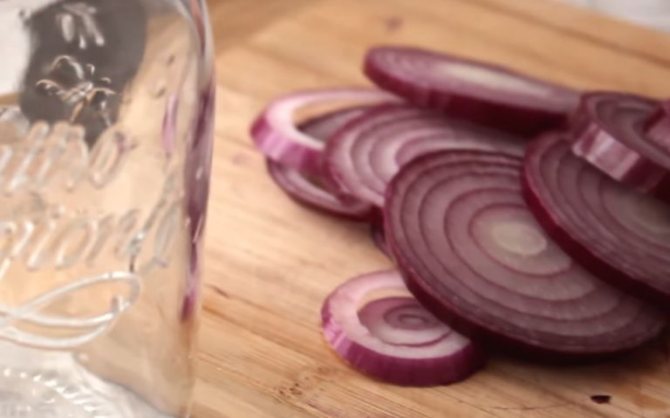

2. Place 2 bay leaves and 4 peppercorns at the bottom of the jar. Place the chopped onion on top and the remaining pepper and bay leaves on top.
3. Boil water. Add salt, sugar and vinegar to it. Stir the marinade thoroughly. For 30% vinegar, dilute 1 part 70% vinegar essence with 1.5 parts water.
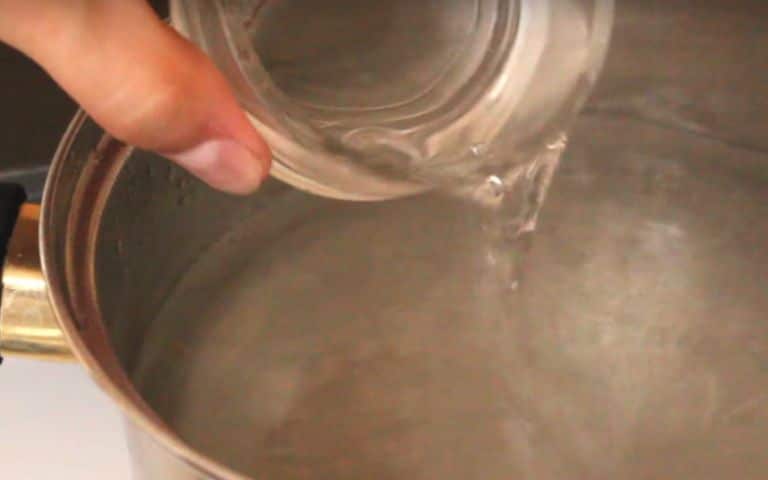

4. Fill the workpiece with liquid, close the lid and place in a warm place.
You can enjoy the finished preservation after 4 hours. Bon Appetit!
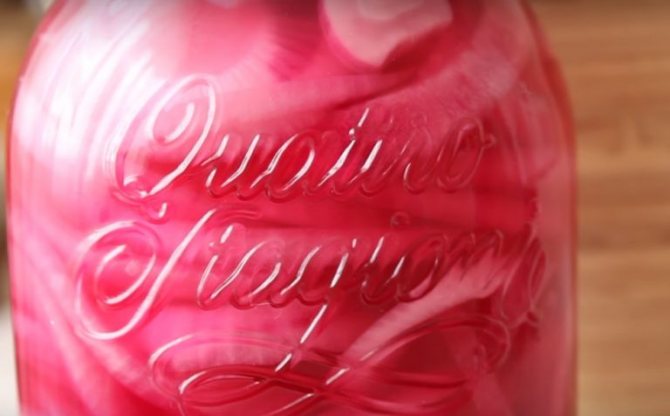

The benefits and harms of potassium permanganate for plants
Since experienced gardeners argue that "processing onions before planting with a weak solution of potassium permanganate is a key stage on the way to a quality product", then this statement must be substantiated.
The benefits of potassium permanganate for plants:
However, there is no need to rush to water all the beds with a solution of potassium permanganate, because this is a chemical compound that can harm the human body (provoke burns of mucous membranes and skin, provoke diseases of the skeletal system), reduce soil productivity, etc.
Important: potassium permanganate can be used to irrigate soils with alkaline or neutral acidity. If you neglect this advice, you can reduce fertility and lose crops (of course, for some varieties of plants, an acidic environment is useful, but not for everyone).
How do you make it so that you get beautiful bulbs that can please the eye throughout the whole year? The answer is simple: "Study the peculiarities of using potassium permanganate (how to properly prepare the composition, water the plants, soak root crops, etc.)"


